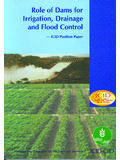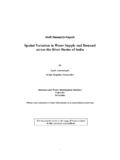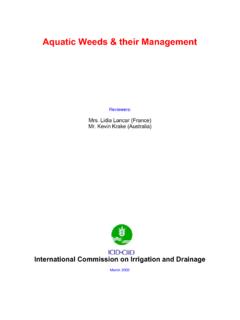Transcription of Role of Dams for Irrigation, Drainage and Flood Control
1 Dams and stakeholders Dams - large and small Although dams have been built in the world since times immemorial, large dam construction was earlier not possible though needed, because of lack of adequate design knowledge, construction equipment, new materials like cement and concrete and technology of construction. Also, economic conditions and institutional capacity existing in countries that needed large dams, did not enable them to take them up. The large dam construction became possible during the 20th century mainly because of advances made in Science and Technology, which enabled mechanisation of construction processes and speedier construction. Improved design procedures and new construction materials enabled the design of larger dams and their components to take on much higher loads and stresses.
2 Also, the needy countries had mobilised finances and built up their capacity by then. Large dams, distinct from Large dams, distinct from smaller ones, enable larger storage of water at suitable smaller ones, enable larger places, thus saving on multiplicity of efforts which would storage of water at suitable be needed to construct several smaller ones. Larger water storages were also found to be necessary by the places, thus saving on society in response to the needs of the growing urban multiplicity of efforts which and industrial centres, generation of hydropower or for would be needed to construct agricultural support. several smaller ones. Main stakeholders The large dams enable harnessing of large water resources potentials, where and when available, to meet needs of fast growing societies round the world: food, fodder, fish production (aquaculture), drinking water, clothing fibres, sanitation, energy, industry, wildlife and others.
3 After several decades of evolving dam construction activity, even today's needs are far from satisfied in many developing regions. These people of the world comprising, farmers who grow food; industries, municipal institutions who use water stored behind the dams, besides the governments who promote water resources development (WRD) are major stakeholders in dams which have been so far built. The need for more dams, especially in developing regions of the world, is still enormous. Societies for whom these dams are crucial for existence have therefore to be considered as the most important stakeholders. 2. Affected people Plans and efforts have been made during the last 2 - 3. decades to see that the people that are adversely affected due to dams are involved in the development process and are treated as stakeholders.
4 However, there are people and organisations who feel strongly that not enough is being done by governments and society while building dams to mitigate their hardships and conserve or improve the environment and ecology. The affected people, undoubtedly, have to be considered major stakeholders alongwith those who are benefited from the dams. Dam builders, funding agencies and professionals After several decades of The planners and builders of dams, users of water, supported by sociologists, economists, politicians who evolving dam construction promote dams form another group of stakeholders. activity, even today's needs There are several associations of these stakeholders. are far from satisfied in Three majors of such world bodies are : many developing regions.
5 * International Commission on Large Dams (ICOLD) established in 1928; The affected people, undoubtedly, have to be * International Commission on irrigation and Drainage (ICID) established in 1950;. considered major stakeholders alongwith those * International Hydropower Association (IHA). who are benefited from the established in 1995. dams. There are some 10 similar world-wide associations of professionals dealing with some of the aspects of dams which can extend help in the matter, wherever required. Recently (1998) the World Commission on Dams (WCD). has been established. ICID. Sustainable irrigated agriculture, Drainage of rainfed crops and of irrigated land, and Flood Control and management - comprise the main action thrusts of the ICID.
6 All these are directed to ensure continued food security through improvement and extension of irrigated and drained areas, increase in productivity and transformation of the rural development scenario throughout the world. A recent report from the 3. International Water Management Institute (IWMI). indicates that even with best irrigation efficiency, the world needs an extension of irrigated areas by building more dams and storages. To achieve these objectives, ICID acts through its country membership, which at present includes 87 countries. Together they account for 95% of the total irrigated area which contributes about 40% of the world food production. It has more than 25 work bodies comprising international experts dealing with some of the issues related to the role of dams for irrigation , Drainage and Flood Control .
7 The themes covered by these bodies include Environmental Impacts of irrigation , Drainage and Flood Control Projects, Socio-economic Impacts and Policy Issues, Research and Development, irrigation and Drainage Performance, Sustainable Use of Natural Resources Sustainable irrigated for Crop Production, etc. The ICID gathers world wide agriculture, Drainage of experience through these work bodies, draws lessons rainfed crops and of and builds them in its strategy for future action. irrigated land and Flood ICID aims to provide better management for the Control and management agricultural lands of the world through the application of comprise the main action science and techniques of irrigation , Drainage and Flood thrusts of the ICID.
8 Control measures. In pursuing its aims, ICID embraces In pursuing its aims, ICID the sound principles of socio-economic values and environmental management. The welfare of the people embraces the sound and preservation of nature are at the heart of it's principles of socio-economic concerns. Dams of all sizes - small, medium and large values and environmental are an essential component of overall and integrated management. water management systems. They divert water, they retain it over long periods of time to use it effectively and they attenuate floods and alleviate impacts of droughts. They relieve Drainage congestion, and they provide for the timely and continuous supply of irrigation water needed to meet the demands of crops and livestock.
9 Existing and new dams will continue to play a major role in the management systems. 4. A Background on Dams 5. Large dams Under what situations large storages are necessary and feasible for promoting irrigation , Drainage or Flood Control vary according to agroclimatic setting. All dams store behind them Flood -waters, primarily for the benefit of human beings. ICOLD defines large dams as those more than 15 m in height, while including smaller dams up to 10 m height as well, if they are otherwise significant with respect to storage volume, density of population, etc. The classification is notional. But because of the effects of scale the larger a dam is, the lower will be the cost of a unit of water stored. Choice and size The storage of water enables removal of mismatch between variable availability and supply, but usually Storages provide insurance more is demanded round the year.
10 For this purpose, against uncertainty due to many reservoirs are designed to carry over storage to climatic variability, can help the next season as well. The variability, if not taken care reduce variability in season's of by such storages, results in droughts and/or floods. low flows in rivers and All dams - large and small and mega to micro, ameliorate such conditions and serve similar purposes. All dams basically save societies from facilitate transport of water to deficit areas by means of economic upheavals and open canals, tunnels or closed pipelines. In a river losses due to Flood and basin, a judicious combination of large and small dams drought. may be required to store water for facilitating withdrawal and use with minimum transport distance to demand regions.










